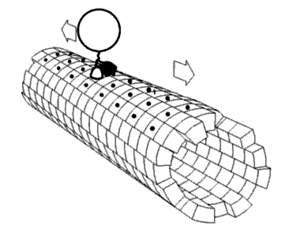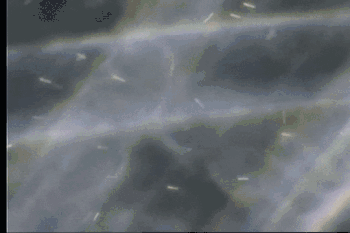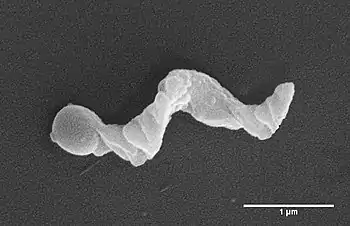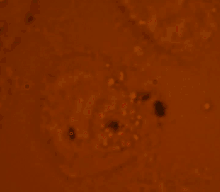Nanomotor
A nanomotor is a molecular or nanoscale device capable of converting energy into movement. It can typically generate forces on the order of piconewtons.[1][2][3][4]
While nanoparticles have been utilized by artists for centuries, such as in the famous Lycurgus cup, scientific research into nanotechnology did not come about until recently. In 1959, Richard Feynman gave a famous talk entitled "There's Plenty of Room at the Bottom" at the American Physical Society's conference hosted at Caltech. He went on to wage a scientific bet that no one person could design a motor smaller than 400 µm on any side.[6] The purpose of the bet (as with most scientific bets) was to inspire scientists to develop new technologies, and anyone who could develop a nanomotor could claim the $1,000 USD prize.[6] However, his purpose was thwarted by William McLellan, who fabricated a nanomotor without developing new methods. Nonetheless, Richard Feynman's speech inspired a new generation of scientists to pursue research into nanotechnology.

Nanomotors are the focus of research for their ability to overcome microfluidic dynamics present at low Reynold's numbers. Scallop Theory explains that nanomotors must break symmetry to produce motion at low Reynold's numbers. In addition, Brownian motion must be considered because particle-solvent interaction can dramatically impact the ability of a nanomotor to traverse through a liquid. This can pose a significant problem when designing new nanomotors. Current nanomotor research seeks to overcome these problems, and by doing so, can improve current microfluidic devices or give rise to new technologies.
Nanotube and nanowire motors
In 2004, Ayusman Sen and Thomas E. Mallouk fabricated the first synthetic and autonomous nanomotor.[7] The two-micron long nanomotors were composed of two segments, platinum and gold, that could catalytically react with diluted hydrogen peroxide in water to produce motion.[7] The Au-Pt nanomotors have autonomous, non-Brownian motion that stems from the propulsion via catalytic generation of chemical gradients.[7][8] As implied, their motion does not require the presence of an external magnetic, electric or optical field to guide their motion.[9] By creating their own local fields, these motors are said to move through self-electrophoresis. Joseph Wang in 2008 was able to dramatically enhance the motion of Au-Pt catalytic nanomotors by incorporating carbon nanotubes into the platinum segment.[10]
Since 2004, different types of nanotube and nanowire based motors have been developed, in addition to nano- and micromotors of different shapes.[11][12][13][14] Most of these motors use hydrogen peroxide as fuel, but some notable exceptions exist.[15][16]

These silver halide and silver-platinum nanomotors are powered by halide fuels, which can be regenerated by exposure to ambient light.[16] Some nanomotors can even be propelled by multiple stimuli, with varying responses.[18] These multi-functional nanowires move in different directions depending on the stimulus (e.g. chemical fuel or ultrasonic power) applied.[18] For example, bimetallic nanomotors have been shown to undergo rheotaxis to move with or against fluid flow by a combination of chemical and acoustic stimuli.[19] In Dresden Germany, rolled-up microtube nanomotors produced motion by harnessing the bubbles in catalytic reactions.[20] Without the reliance on electrostatic interactions, bubble-induced propulsion enables motor movement in relevant biological fluids, but typically still requires toxic fuels such as hydrogen peroxide.[20] This has limited nanomotors' in vitro applications. One in vivo application, however, of microtube motors has been described for the first time by Joseph Wang and Liangfang Zhang using gastric acid as fuel.[21] Future research into catalytical nanomotors holds major promise for important cargo-towing applications, ranging from cell sorting microchip devices to directed drug delivery.

Enzymatic nanomotors
Recently, there has been more research into developing enzymatic nanomotors and micropumps. At low Reynold's numbers, single molecule enzymes could act as autonomous nanomotors.[22][23] Ayusman Sen and Samudra Sengupta demonstrated how self-powered micropumps can enhance particle transportation.[24][25] This proof-of-concept system demonstrates that enzymes can be successfully utilized as an "engine" in nanomotors and micropumps.[26] It has since been shown that particles themselves will diffuse faster when coated with active enzyme molecules in a solution of their substrate.[27][28] Further, it has been seen through microfluidic experiments that enzyme molecules will undergo directional swimming up their substrate gradient.[29][30] This remains the only method of separating enzymes based on activity alone. Additionally, enzymes in cascade have also shown aggregation based on substrate driven chemotaxis.[31] Developing enzyme-driven nanomotors promises to inspire new biocompatible technologies and medical applications.[32]
A proposed branch of research is the integration of molecular motor proteins found in living cells into molecular motors implanted in artificial devices. Such a motor protein would be able to move a "cargo" within that device, via protein dynamics, similarly to how kinesin moves various molecules along tracks of microtubules inside cells. Starting and stopping the movement of such motor proteins would involve caging the ATP in molecular structures sensitive to UV light. Pulses of UV illumination would thus provide pulses of movement. DNA nanomachines, based on changes between two molecular conformations of DNA in response to various external triggers, have also been described.
Helical nanomotors
Another interesting direction of research has led to the creation of helical silica particles coated with magnetic materials that can be maneuvered using a rotating magnetic field.[33]

Such nanomotors are not dependent on chemical reactions to fuel the propulsion. A triaxial Helmholtz coil can provide directed rotating field in space. Recent works have shown how such nanomotors can be used to measure viscosity of non-newtonian fluids at a resolution of a few microns.[34] This technology promises creation of viscosity map inside cells and the extracellular milieu. Such nanomotors have been demonstrated to move in blood.[35] Recently, researchers have managed to controllably move such nanomotors inside cancer cells allowing them to trace out patterns inside a cell.[5] Nanomotors moving through the tumor microenvironment have demonstrated the presence of sialic acid in the cancer-secreted extracellular matrix.[36]
Current-driven nanomotors (Classical)
In 2003 Fennimore et al. presented the experimental realization of a prototypical current-driven nanomotor.[37] It was based on tiny gold leaves mounted on multiwalled carbon nanotubes, with the carbon layers themselves carrying out the motion. The nanomotor is driven by the electrostatic interaction of the gold leaves with three gate electrodes where alternate currents are applied. Some years later, several other groups showed the experimental realizations of different nanomotors driven by direct currents.[38] [39]The designs typically consisted of organic molecules adsorbed on a metallic surface with a scanning-tunneling-microscope (STM) on top of it. The current flowing from the tip of the STM is used to drive the directional rotation of the molecule[39] or of a part of it.[38] The operation of such nanomotors relies on classical physics and is related to the concept of Brownian motors.[40] These examples of nanomotors are also known as molecular motors.
Quantum effects in current-driven nanomotors
Due to their small size, quantum mechanics plays an important role in some nanomotors. For example, in 2020 Stolz et al. showed the cross-over from classical motion to quantum tunneling in a nanomotor made of a rotating molecule driven by the STM's current.[41] Cold-atom-based ac-driven quantum motors have been explored by several authors.[42] [43] Finally, reverse quantum pumping has been proposed as a general strategy towards the design of nanomotors.[44] In this case, the nanomotors are dubbed as adiabatic quantum motors and it was shown that the quantum nature of electrons can be used to improve the performance of the devices.
See also
References
- Dreyfus, R.; Baudry, J.; Roper, M. L.; Fermigier, M.; Stone, H. A.; Bibette, J. (2005). "Microscopic artificial swimmers". Nature. 437 (7060): 862–5. doi:10.1038/nature04090. PMID 16208366.
- Bamrungsap, S.; Phillips, J. A.; Xiong, X.; Kim, Y.; Wang, H.; Liu, H.; Hebard, A.; Tan, W. (2011). "Magnetically driven single DNA nanomotor". Small. 7 (5): 601–605. doi:10.1002/smll.201001559. PMID 21370463.
- T. E. Mallouk and A. Sen, "Powering nanorobots," Scientific American, May 2009, pp. 72-77
- J. Wang, "Nanomachines: Fundamental and Application", Wiley, 2013
- Pal, Malay; Somalwar, Neha; Singh, Anumeha; Bhat, Ramray; Eswarappa, Sandeep; Saini, Deepak; Ghosh, Ambarish (2018). "Maneuverability of Magnetic Nanomotors Inside Living Cells". Advanced Materials. 30 (22): 1800429. doi:10.1002/adma.201800429. PMID 29635828.
- "Physics Term Paper -- Nanotechnology". www.geocities.ws. Retrieved 2015-10-30.
- Paxton, W. F.; Kistler, K. C.; Olmeda, C. C.; Sen, A.; Cao, Y.; Mallouk, T. E.; Lammert, P.; Crespi, V. H. (2004). "Autonomous Movement of Striped Nanorods". J. Am. Chem. Soc. 126 (41): 13424–13431. doi:10.1021/ja047697z. PMID 15479099.
- Wang, Wei; Duan, Wentao; Ahmed, Suzanne; Mallouk, Thomas E.; Sen, Ayusman (2013-10-01). "Small power: Autonomous nano- and micromotors propelled by self-generated gradients". Nano Today. 8 (5): 531–554. doi:10.1016/j.nantod.2013.08.009.
- Yadav, Vinita; Duan, Wentao; Butler, Peter J.; Sen, Ayusman (2015-01-01). "Anatomy of Nanoscale Propulsion". Annual Review of Biophysics. 44 (1): 77–100. doi:10.1146/annurev-biophys-060414-034216. PMID 26098511.
- Speeding up catalytic nanomotors with carbon nanotubes
- Das, Sambeeta; Garg, Astha; Campbell, Andrew I.; Howse, Jonathan; Sen, Ayusman; Velegol, Darrell; Golestanian, Ramin; Ebbens, Stephen J. (2015). "Boundaries can steer active Janus spheres". Nature Communications. 6 (1): 8999. doi:10.1038/ncomms9999. ISSN 2041-1723. PMC 4686856. PMID 26627125.
- Duan, W.; Ibele, M.; Liu, R.; Sen, A. (2012). "Motion analysis of light-powered autonomous silver chloride nanomotors". The European Physical Journal E. 35 (8): 77. doi:10.1140/epje/i2012-12077-x. ISSN 1292-8941. PMID 22926808.
- Baker, Matthew S.; Yadav, Vinita; Sen, Ayusman; Phillips, Scott T. (2013). "A Self-Powered Polymeric Material that Responds Autonomously and Continuously to Fleeting Stimuli". Angewandte Chemie International Edition. 52 (39): 10295–10299. doi:10.1002/anie.201304333. ISSN 1433-7851. PMID 23939613.
- Zhang, Hua; Duan, Wentao; Liu, Lei; Sen, Ayusman (2013). "Depolymerization-Powered Autonomous Motors Using Biocompatible Fuel". Journal of the American Chemical Society. 135 (42): 15734–15737. doi:10.1021/ja4089549. ISSN 0002-7863. PMID 24094034.
- Liu, Ran; Wong, Flory; Duan, Wentao; Sen, Ayusman (2014-12-14). "Synthesis and characterization of silver halide nanowires". Polyhedron. Special Issue in Honor of Professor John E. Bercaw. 84: 192–196. doi:10.1016/j.poly.2014.08.027.
- Wong, Flory; Sen, Ayusman (2016-07-26). "Progress toward Light-Harvesting Self-Electrophoretic Motors: Highly Efficient Bimetallic Nanomotors and Micropumps in Halogen Media". ACS Nano. 10 (7): 7172–7179. doi:10.1021/acsnano.6b03474. ISSN 1936-0851. PMID 27337112.
- Ahmed, Suzanne; Wang, Wei; Mair, Lamar; Fraleigh, Robert; Li, Sixin; Castro, Luz Angelica; Hoyos, Mauricio; Huang, Tony Jun; Mallouk, Thomas E. (2013-12-10). "Steering acoustically propelled nanowire motors towards cells in a biologically compatible environment using magnetic fields". Langmuir. 29 (52): 16113–16118. doi:10.1021/la403946j. PMID 24345038.
- Wang, Wei; Duan, Wentao; Zhang, Zexin; Sun, Mei; Sen, Ayusman; Mallouk, Thomas E. (2014-12-18). "A tale of two forces: simultaneous chemical and acoustic propulsion of bimetallic micromotors". Chemical Communications. 51 (6): 1020–1023. doi:10.1039/C4CC09149C. ISSN 1364-548X. PMID 25434824.
- Ren, Liqiang; Zhou, Dekai; Mao, Zhangming; Xu, Pengtao; Huang, Tony Jun; Mallouk, Thomas E. (2017-09-18). "Rheotaxis of Bimetallic Micromotors Driven by Chemical–Acoustic Hybrid Power". ACS Nano. 11 (10): 10591–10598. doi:10.1021/acsnano.7b06107. ISSN 1936-0851. PMID 28902492.
- Mei, Yongfeng; Solovev, Alexander A.; Sanchez, Samuel; Schmidt, Oliver G. (February 22, 2011). "Rolled-up nanotech on polymers: from basic perception to self-propelled catalytic microengines". Chemical Society Reviews. 40 (5): 2109–19. doi:10.1039/c0cs00078g. PMID 21340080.
- Gao, Wei; Dong, Renfeng; Thamphiwatana, Soracha; Li, Jinxing; Gao, Weiwei; Zhang, Liangfang (2015). "Artificial Micromotors in the Mouse's Stomach: A Step toward in Vivo Use of Synthetic Motors". ACS Nano. 9 (1): 117–23. doi:10.1021/nn507097k. PMC 4310033. PMID 25549040.
- Duan, Wentao; Wang, Wei; Das, Sambeeta; Yadav, Vinita; Mallouk, Thomas E.; Sen, Ayusman (2015-01-01). "Synthetic Nano- and Micromachines in Analytical Chemistry: Sensing, Migration, Capture, Delivery, and Separation". Annual Review of Analytical Chemistry. 8 (1): 311–333. doi:10.1146/annurev-anchem-071114-040125. PMID 26132348.
- Sengupta, Samudra; Dey, Krishna K.; Muddana, Hari S.; Tabouillot, Tristan; Ibele, Michael E.; Butler, Peter J.; Sen, Ayusman (2013-01-30). "Enzyme Molecules as Nanomotors". Journal of the American Chemical Society. 135 (4): 1406–1414. doi:10.1021/ja3091615. ISSN 0002-7863. PMID 23308365.
- Sengupta, Samudra; Dey, Krishna K.; Muddana, Hari S.; Tabouillot, Tristan; Ibele, Michael E.; Butler, Peter J.; Sen, Ayusman (2013-01-30). "Enzyme Molecules as Nanomotors". Journal of the American Chemical Society. 135 (4): 1406–1414. doi:10.1021/ja3091615. ISSN 0002-7863. PMID 23308365.
- Sengupta, Samudra; Patra, Debabrata; Ortiz-Rivera, Isamar; Agrawal, Arjun; Shklyaev, Sergey; Dey, Krishna K.; Córdova-Figueroa, Ubaldo; Mallouk, Thomas E.; Sen, Ayusman (2014-05-01). "Self-powered enzyme micropumps". Nature Chemistry. 6 (5): 415–422. doi:10.1038/nchem.1895. ISSN 1755-4330. PMID 24755593.
- Sengupta, Samudra; Spiering, Michelle M.; Dey, Krishna K.; Duan, Wentao; Patra, Debabrata; Butler, Peter J.; Astumian, R. Dean; Benkovic, Stephen J.; Sen, Ayusman (2014-03-25). "DNA Polymerase as a Molecular Motor and Pump". ACS Nano. 8 (3): 2410–2418. doi:10.1021/nn405963x. ISSN 1936-0851. PMID 24601532.
- Dey, Krishna K.; Zhao, Xi; Tansi, Benjamin M.; Méndez-Ortiz, Wilfredo J.; Córdova-Figueroa, Ubaldo M.; Golestanian, Ramin; Sen, Ayusman (2015-12-09). "Micromotors Powered by Enzyme Catalysis". Nano Letters. 15 (12): 8311–8315. doi:10.1021/acs.nanolett.5b03935. ISSN 1530-6984. PMID 26587897.
- Ma, Xing; Jannasch, Anita; Albrecht, Urban-Raphael; Hahn, Kersten; Miguel-López, Albert; Schäffer, Erik; Sánchez, Samuel (2015-10-14). "Enzyme-Powered Hollow Mesoporous Janus Nanomotors". Nano Letters. 15 (10): 7043–7050. doi:10.1021/acs.nanolett.5b03100. ISSN 1530-6984. PMID 26437378.
- Sengupta, Samudra; Dey, Krishna K.; Muddana, Hari S.; Tabouillot, Tristan; Ibele, Michael E.; Butler, Peter J.; Sen, Ayusman (2013-01-30). "Enzyme Molecules as Nanomotors". Journal of the American Chemical Society. 135 (4): 1406–1414. doi:10.1021/ja3091615. ISSN 0002-7863. PMID 23308365.
- Dey, Krishna Kanti; Das, Sambeeta; Poyton, Matthew F.; Sengupta, Samudra; Butler, Peter J.; Cremer, Paul S.; Sen, Ayusman (2014-12-23). "Chemotactic Separation of Enzymes". ACS Nano. 8 (12): 11941–11949. doi:10.1021/nn504418u. ISSN 1936-0851. PMID 25243599.
- Zhao, Xi; Palacci, Henri; Yadav, Vinita; Spiering, Michelle M.; Gilson, Michael K.; Butler, Peter J.; Hess, Henry; Benkovic, Stephen J.; Sen, Ayusman (2017-12-18). "Substrate-driven chemotactic assembly in an enzyme cascade". Nature Chemistry. 10 (3): 311–317. doi:10.1038/nchem.2905. ISSN 1755-4330. PMID 29461522.
- Zhao, Xi; Gentile, Kayla; Mohajerani, Farzad; Sen, Ayusman (2018-10-16). "Powering Motion with Enzymes". Accounts of Chemical Research. 51 (10): 2373–2381. doi:10.1021/acs.accounts.8b00286. ISSN 0001-4842. PMID 30256612.
- Ghosh, Ambarish; Fischer, Peer (2009). "Controlled Propulsion of Artificial Magnetic Nanostructured Propellers". Nano Letters. 9 (6): 2243–2245. doi:10.1021/nl900186w. PMID 19413293.
- Ghosh, Arijit; Dasgupta, Debayan; Pal, Malay; Morozov, Konstantin; Lehshansky, Alexander; Ghosh, Ambarish (2018). "Helical Nanomachines as Mobile Viscometers". Advanced Functional Materials. 28 (25): 1705687. doi:10.1002/adfm.201705687.
- Pooyath, Lekshmy; Sai, Ranajit; Chandorkar, Yashoda; Basu, Bikramjit; Shivashankar, S; Ghosh, Ambarish (2014). "Conformal cytocompatible ferrite coatings facilitate the realization of a nanovoyager in human blood". Nano Letters. 14 (4): 1968–1975. doi:10.1021/nl404815q. PMID 24641110.
- Dasgupta, Debayan; Pally, Dharma; Saini, Deepak; Bhat, Ramray; Ghosh, Ambarish (2020). "Nanomotors Sense Local Physicochemical Heterogeneities in Tumor Microenvironments". Angewandte Chemie. doi:10.1002/anie.202008681.
- Fennimore, A. M.; Yuzvinsky, T. D.; W.-Q., Han; M. S., Fuhrer; J., Cumings; A., Zettl (2003). "Rotational actuators based on carbon nanotubes". Nature. 424: 424. doi:10.1038/nature01823.
- Tierney, Heather L.; Murphy, Colin J.; Jewell, April D.; Baber, Ashleigh E.; Iski, Erin V.; Khodaverdian, Harout Y.; McGuire, Allister F.; Klebanov, Nikolai; Sykes, E. Charles H. (2011). "Experimental demonstration of a single-molecule electric motor". Nat. Nanotech. 6: 625-629. doi:10.1038/nnano.2011.142.
- Kudernac, T.; Ruangsupapichat, N.; Parschau, M.; Macia, B.; Katsonis, N.; Harutyunyan, S. R.; Ernst, K.-H.; Feringa, B. L. (2011). "Electrically driven directional motion of a four-wheeled molecule on a metal surface". Nature. 479: 208. doi:10.1038/nature10587.
- Hänggi, Peter; Marchesoni, Fabio (2009). "Artificial Brownian motors: Controlling transport on the nanoscale". Rev. Mod. Phys. 81: , 387-442. doi:10.1103/RevModPhys.81.387.
- Stolz, Samuel; Gröning, Oliver; Prinz, Jan; Brune, Harald; Widmer, Roland (2020). "Molecular motor crossing the frontier of classical to quantum tunneling motion". PNAS. 117: 14838-14842. doi:10.1073/pnas.1918654117.
- Ponomarev, A. V.; Denisov, S.; Hänggi, P. (2009). "ac-Driven Atomic Quantum Motor". Phys. Rev. Lett. 102: 230601. arXiv:0902.0489. doi:10.1103/PhysRevLett.102.230601.
- Salger, T.; Kling, S.; Hecking, T.; Geckeler, C.; Morales-Molina, L.; Weitz, M. (2009). "Directed Transport of Atoms in a Hamiltonian Quantum Ratchet". Science. 326: 1241. arXiv:0912.0102. doi:10.1126/science.1179546.
- Bustos-Marún, Raúl; Refael, Gil; von Oppen, Felix (2013-08-05). "Adiabatic Quantum Motors". Physical Review Letters. American Physical Society (APS). 111 (6): 060802. arXiv:1304.4969. doi:10.1103/physrevlett.111.060802. ISSN 0031-9007.
External links
- Berkeley.edu – Physicists build world's smallest motor
- Nanotube Nanomotor research project
- Nonomotor
- Nanotechnology, nanomotor, and nanopump

